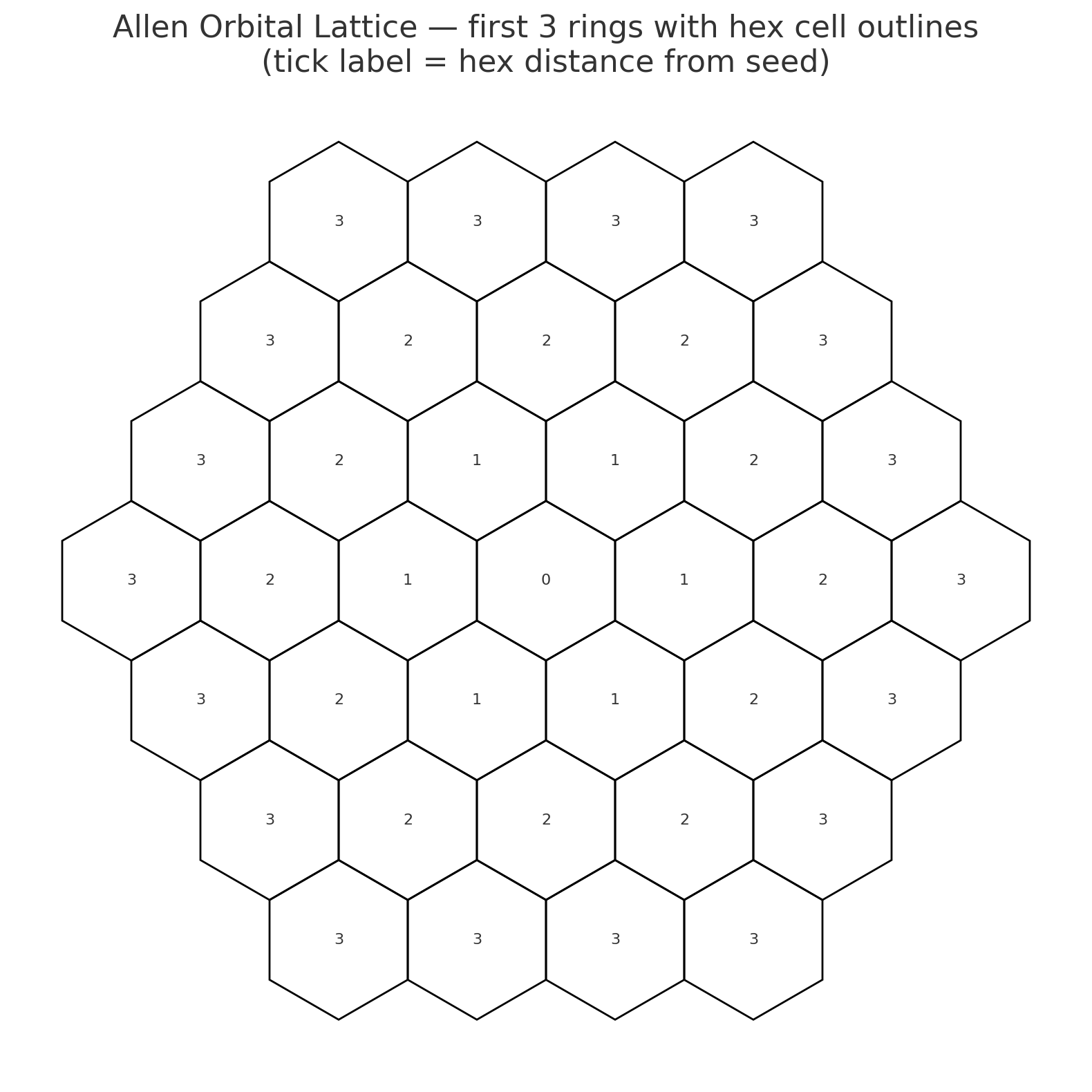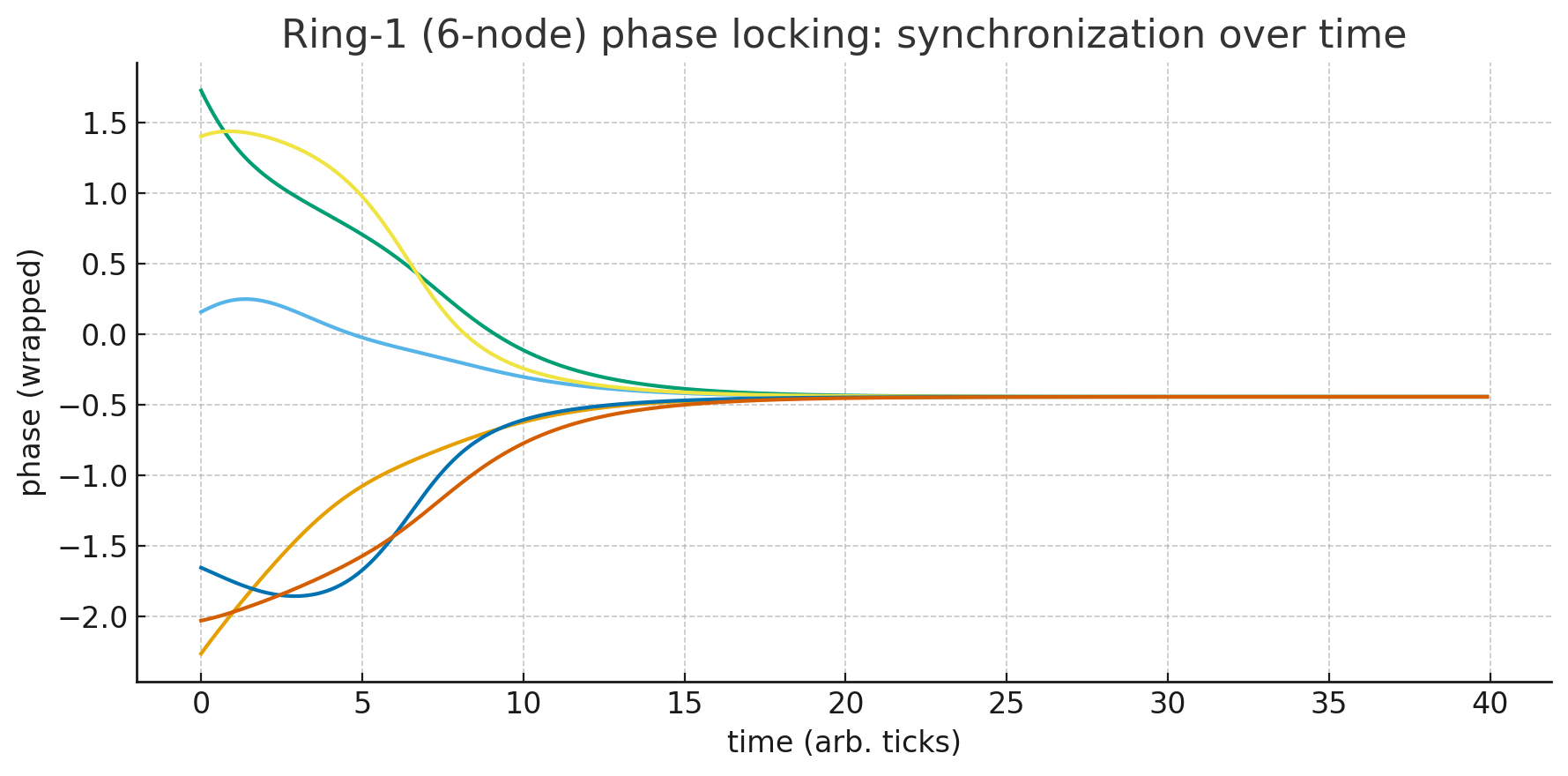Before the Bang
Before the Breach, Emergence (1D), and the Unfolding of the Allen Orbital Lattice (2D)
π-particle — the first carrier: a boundary-holding, time-keeping unit (1D).
Allen Orbital Lattice (AOL) — a 2D network of carriers synchronized for routing and coordination.
Differentiat — the operator that produces relational variation/tension (drives divergence).
Equilibrion — the commit/verification that resolves or balances a configuration (locks coherence).
Coherence Evaluations — atemporal relational evaluations; not events in time, but the logical preconditions that allow time to exist as a coherent continuum of localized instantiations. The Differentiat generates candidates in the π-field; the Equilibrion commits/verifies them.
Executive Summary
- Mainstream baseline: The early universe underwent accelerated expansion (inflation) and later reheating into a hot, dense plasma. The “bang” is the metric expanding, not a bomb in empty space.
- PFT addition: Before the 2D→3D breach, carriers already exist — the first π-closure (1D) and the AOL network (2D) — but there is no 3D channel for radiance. The first carrier arises at π-closure, installing the First Memory \((\Delta \ell,\Delta \tau)\) with \(c=\Delta \ell/\Delta \tau\).
- Carriers → fabric: Six neighbors around the seed form Ring-1 (AOL). With carriers and coordination, the fabric can stretch; inflation is read as rapid coordination and metric growth. 3D radiance appears only after the breach adds volume.
What “carriers” means (plain language)
In PFT, carriers (the first is the π-particle) are units that hold a stable boundary, keep a tick, and pass an update to neighbors. Many carriers linked together form a carrier network (the AOL) that can route and synchronize. After the 2D→3D breach, this same network provides the transport layer, anchor points, and local axes that constrain and route radiative packets (light) in 3D.
1) What Physics Means by the Big Bang
Standard cosmology models a hot, dense, expanding early universe. Many versions include an initial inflationary phase (accelerated expansion from a high-energy vacuum-like state), then reheating that populates radiation and particles. Observables such as near-flat geometry and a nearly scale-invariant perturbation spectrum support this picture.
Not an explosion into an outside: the metric itself expands.
2) Before the Breach (carriers present, no 3D light)
Before the 2D→3D breach we already have carriers: first the π-particle (a single boundary-holding, time-keeping unit), then the AOL (a 2D network of carriers). They coordinate and route in 2D, but there is no volumetric channel yet, so light cannot express in 3D. Only pre-emergence (pre-π) lacks carriers entirely. “Cold” here means non-thermal: temperature isn’t applicable without degrees of freedom to store or equilibrate heat.
- Pre-π (no carriers): Isotropy selects the circle when a closure finally stabilizes (isoperimetric closure).
- Emergence (π, 1D): First carrier writes the First Memory \(c=\Delta \ell/\Delta \tau\) (proper time begins locally).
- AOL (2D): Carriers synchronize and route; radiance awaits the 2D→3D breach.
2.5) Coherence Evaluations Pre-Breach
Prior to volumetric (3D) expression, Coherence Evaluations still govern what can stabilize: they are atemporal relational evaluations within the π-particle → AOL regime. The Differentiat explores configurations on the AOL; a configuration is evaluable (eligible) for balance if its relations are self-compatible. The Equilibrion then performs the commit/verification that locks a coordination step. We do not measure this as “time” yet—time emerges as a coherent continuum only after sufficient commit structure exists to project continuity locally.
3) Emergence (First Dimension): the π-Closure
A successful pre-closure stabilizes as the first circle — the π-particle — installing the First Memory, a minimal step and tick \((\Delta \ell,\Delta \tau)\) whose ratio \(c=\Delta \ell/\Delta \tau\) is the universal propagation bound. One carrier is not yet a network; volumetric expression is still absent.
In PFT, the ratio \(c=\Delta \ell/\Delta \tau\) is tied to Equilibrion commit structure: every successful commit preserves that bound across carriers, which is why \(c\) remains universal when projected post-breach.
4) The Second Dimension: Unfolding the AOL (Ring-1)
The second dimension begins when six π-closures nucleate around the seed, forming Ring-1 of the Allen Orbital Lattice (AOL) — the first transport-capable neighborhood. Growth proceeds with a front speed bounded by the First Memory: in shorthand, π-particles “reproduce at \(c\).”
Formation of Ring-1 constitutes a series of Equilibrion commits over Coherence Evaluations: each neighbor relation that stabilizes expands the routing domain under the same First Memory bound.

5) Synchronization & Group Time
Each π-particle carries proper time; rings phase-lock into group time. As rings couple to rings, a lattice-level coordinated time emerges. Increased enclosure density or routing load strains locking — appearing as slower group time (PFT’s framing of time dilation).
Formally: group time appears when sequences of Coherence Evaluations are successfully committed by the Equilibrion across a neighborhood—yielding locally consistent tick relationships that project as shared duration.

6) Lift Toward 3D and Inflation
As AOL rings propagate (Ring-2, Ring-3…), coordination and drive cross a threshold and closures extrude — lifting toward volumetric structure. In this lens, inflation is a phase of rapid coordination and metric growth once a carrier fabric exists; reheating then yields the familiar hot, particle-filled universe.
In this lens, the rapidity is not “stored energy exploding,” but an Equilibrion-mediated cascade of committed Coherence Evaluations across an enlarging coordination front; reheating then populates radiative and particle degrees of freedom in the new volumetric channel.
7) How light travels “in straight lines” on an orbital lattice
After the breach, radiative packets (light) are routed across the carrier fabric. Each hop has a fixed tick (First Memory) and a small turn cost. The packet obeys a lattice version of Fermat’s principle: it follows the least-delay, least-turn route. On a nearly isotropic lattice, repeating that choice produces macroscopic paths that are straight in the continuum limit. Inhomogeneity (strain/density/clock gradients) renormalizes hop cost and bends the path — refraction and lensing in PFT terms.
Each hop is permitted only where the local relations satisfy a Coherence Evaluation; the Equilibrion commit makes the hop real. Repeating least-delay, least-turn commits yields geodesic-like macroscopic routes.
In short: discrete geodesics on the lattice → straight lines on average; gradients curve them.
8) Why light appears only after the breach
- No 3D channel before breach: 1D/2D carriers route and synchronize but cannot express volumetric radiance.
- After the breach: The carrier network becomes the transport layer and provides anchors/axes for light; when drive outruns relaxation, routing mode-converts into electromagnetic packets (light).
9) If the AOL “blew up,” what lattice do we see today?
Not a single global hex grid. The AOL is the boot lattice: it writes the First Memory and synchronizes early routing. After the 2D→3D breach and rapid stretch, a universal hex tiling does not survive. What persists is: (i) the rule set (First Memory, symmetries), (ii) local carrier domains that re-lock, and (iii) re-expressions of AOL-favored geometry wherever energetically preferred.
- Vacuum today: effectively isotropic carrier fabric — no crystalline grid. Light follows least-delay routes; averaged, they’re straight unless gradients bend them.
- Matter lattices: hex/FCC/BCC etc. are local condensates where the same symmetry/least-strain rules minimize energy — echoes, not the primordial sheet.
- Cosmic structure: filaments/voids reflect routing/minimization over long times, not a frozen hex template.
10) What This Adds (and How to Check It)
- Origin of \(c\): \(c\) is the First Memory at π-closure, not a later bolt-on.
- Time’s start: Proper time begins at emergence; shared time is synchronization across carriers.
- Minimal-part echoes (lab-scale): In ultrafast fracture/discharge/ignition, earliest geometry biases to ring/arc (π-first), then jumps to tubular/plume at a threshold (extrusion).
- Clock–symmetry link: More symmetric closures make more stable clocks (mirroring best physical resonators).
Time is not a backdrop. It is the projection of committed Coherence Evaluations into local continuity. Before the 2D→3D breach, evaluations exist (atemporally) and commits occur (logically), but they do not yet project as volumetric, clock-measurable duration. After the breach, coordinated commits across carriers produce the familiar sense of flow.
11) FAQ (brief)
Was everything “cold”? In the precise sense: non-thermal. Temperature wasn’t applicable before volumetric degrees of freedom.
Does PFT contradict inflation? No. PFT supplies the pre-volumetric hinge (π → AOL). Inflation then acts on a fabric that exists and coordinates.
Where does light come from? Post-breach routing (FCC) that mode-converts into EM packets when driven beyond relaxation.
Note: PFT sections are conjectural but falsifiable structure layered atop the mainstream cosmological baseline.
PFT — Pattern Field Theory · π-particle — first carrier (1D) · AOL — Allen Orbital Lattice (2D) · CE — Coherence Evaluations · EM — Electromagnetic · CMBR — Cosmic Microwave Background Radiation